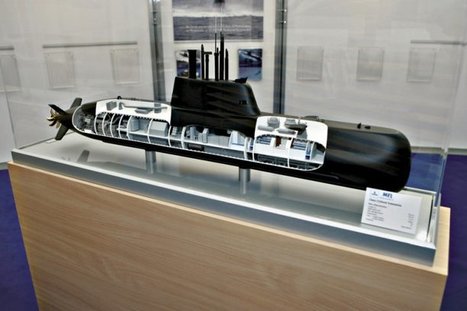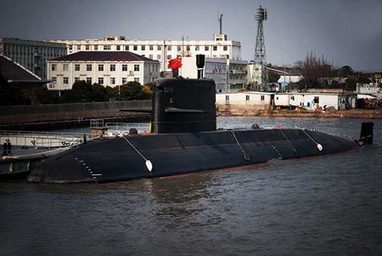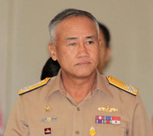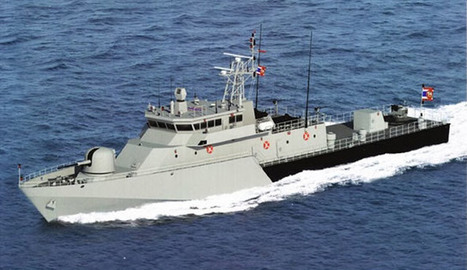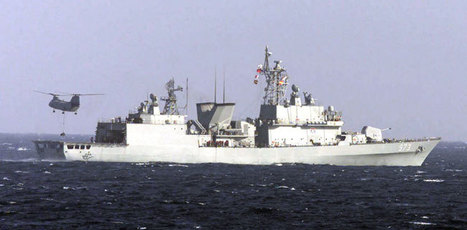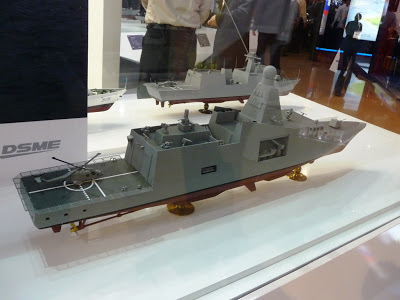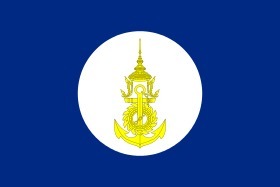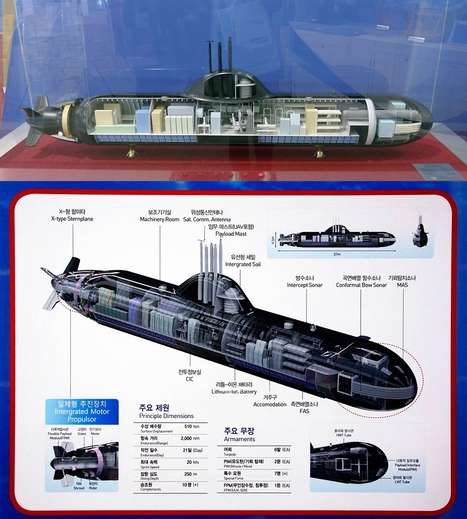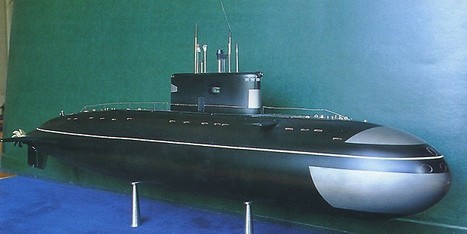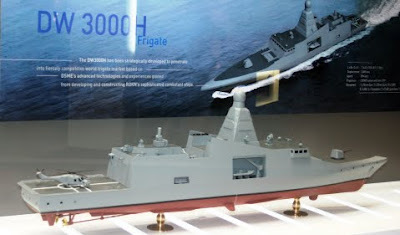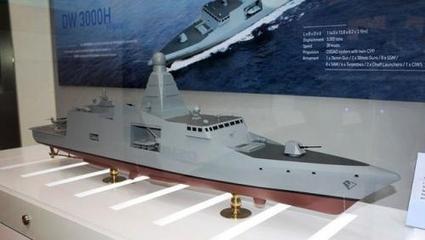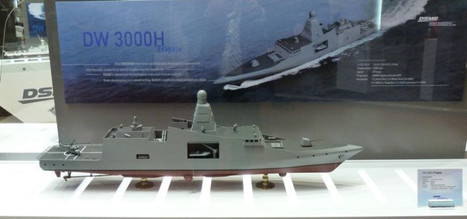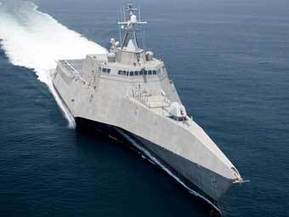 Your new post is loading...

|
Scooped by
Patrick H.
March 29, 2015 1:26 PM
|
A plan to buy submarines for the Royal Thai Navy is on again with strong backing from Defence Minister Prawit Wongsuwon who wants Thailand’s fleet to be on par with neighbouring countries.
The sub plan, which has surfaced periodically over the years, re-emerged when Gen Prawit on Wednesday said the country needed to equip its navy with submarines as part of efforts to modernise the armed forces.
The defence minister said chances were good that the navy can fulfil its deep yearning for submarines, but he stopped short of saying when funds would be allocated.
"I can't say exactly how many percent (chance there is). But when I said the navy has a chance, it means more than 50% or 60%,'' he told reporters.
The budget could be around 36 billion baht. In July, the navy opened an ultra-modern, 540-million-baht submarine base and training centre in Chon Buri province, even though the country doesn't own a single sub. Thailand has not had a submarine since 1951, but has been trying for several years to get some. In 2011, the military negotiated to buy six small used submarines from Germany for 7.7 billion baht and considered buying two larger new vessels from South Korea, but both deals fell through.
Navy officials say they want submarines to protect the Gulf of Thailand and Thai interests on the high seas. But one worry is the spat over the South China Sea's Spratly Islands — claimed in part or in whole by Brunei, China, Malaysia, Philippines, Taiwan and Vietnam — could erupt into a regional conflict that destabilises the region.
The high-ticket price was the factor, however, that ultimately sank the submarine plan. This week, however, Gen Prawit asserted that the country needs submarines to keep up with other Asean countries. Malaysia, Singapore and Vietnam all have them.
Keeping up with the neighbours
A navy source said the navy quietly set up a committee commanded by chief of staff Thanarat Ubon to dust off the project in December after Gen Prawit gave navy officers a green light. The panellists visited visited Germany, Spain and South Korea, with China set to be their next stop in investigating sub sellers. The navy wants to buy two diesel-powered submarines with displacement of 2,400-3,000 tonnes.
The source said the Chinese-made Yuan class is favoured by the committee due to its specifications. The U-class from South Korea and Germany also pinged the sonar screen.
Chinese Defence Minister Chang Wanquan offered to sell weapons with special conditions and ''friendship price tags'' to Thailand twice when Gen Prawit visited Beijing in November. The offer, which also included 10-year payment plans, was repeated when the Chinese minister came to Bangkok last month.
The source said navy chief Adm Kraisorn Chansuwanit planned to swap the position between Adm Thanarat and Narongphol Na Bangchang, who is a deputy chief of staff at the Supreme Command, in a mid-year reshuffle to speed up the sub project. Adm Narongphol was a key figure on the submarine team before he was moved to the Supreme Command, the source added.

|
Scooped by
Patrick H.
January 30, 2015 11:46 AM
|
Cut-away model of the Type 210mod advanced compact submarine design by ThyssenKrupp Marine Systems' Howaldtswerke-Deutsche Werft (HDW) shipyard. (Michael Nitz - Naval Press Service) Germany's ThyssenKrupp Marine Systems (TKMS) has made a double submarine offer to Thailand featuring the company's Type 209/1400mod and Type 210mod platforms, IHS Jane's understands. The company highlighted the capabilities of the two submarines in meetings in Bangkok recently as part of the Royal Thai Navy's (RTN's) continuing review of submarine platforms, said sources. This evaluation programme - which has also featured Russia's Kilo-class Project 636 submarine and China's Yuan-class (Type 041) platform - is in support of the RTN's plan to procure up to three submarines within the next few years. South Korea's Daewoo Shipbuilding & Marine Engineering's Chang Bogo-class (Type 209) submarine is also expected to be evaluated by the RTN.

|
Scooped by
Patrick H.
January 16, 2015 1:03 PM
|
The state-run China Shipbuilding Industry Corporation officially introduced its S-26T submarine to the defense ministry of Thailand on Jan. 12 to strengthen the military-to-military relationship between Beijing and Bangkok, according to Duowei News, an outlet operated by overseas Chinese. After the decommissioning of the Royal Thai Navy's four Matchanu-class submarines, the nation has not operated submarines for more than 60 years. Now, however, some officials in the country's military government believe submarines are needed to defend the nation's freedom of navigation in the Gulf of Thailand. To rebuild its submarine fleet, the government decided to buy two or three submarines in Fiscal year 2016. China is the third nation to demonstrate interest in selling submarines to Thailand, after France and South Korea. By selling submarines to Thailand, China aims to gain a potential political and defense partner in South China Sea disputes with its neighbors at a time when Vietnam is also purchasing Kilo-class submarines from Russia. Over the past 20 years, Thailand had signed contracts with Germany and South Korea to buy new submarines and considered buying S-20 submarines from China. These plans all fell through however due to repeated economic and political crises. As tensions escalate between rival claimants in the disputed South China Sea, Thailand has begun to feel that submarines are once again important to defend its national security, even though the country itself does not make territorial claims in the sea. While the S-20 is the export version of the Type 039A Yuan-class diesel-electric submarine, the full details of the S-26T remain mysterious but its main competitor for the Royal Thai Navy's contract will be South Korea's Chang Bogo-class submarine.

|
Scooped by
Patrick H.
November 20, 2014 10:53 AM
|
The Royal Thai Navy will dust off a proposal to buy submarines after years of failed attempts to equip itself with the expensive underwater craft. Navy chief Kraisorn Chansuwanich revealed the plan on Thursday, which marks Royal Thai Navy Day. Adm Kraisorn said he had proposed the navy’s latest development plan, which includes the bid to procure submarines, to Deputy Prime Minister and Defence Minister Prawit Wongsuwon during his visit to navy headquarters on Monday. Adm Kraisorn said Gen Prawit agreed with the planned procurement of submarines and instructed the navy to present detailed studies on the types of submarines it wanted and the cost to see if they are affordable. The navy has pressed governments for years to buy submarines to help protect the Gulf of Thailand. The bid to equip the navy with submarines began when Banharn Silpa-archa was prime minister in 1995. Back then, Kockums of Sweden were the prime target. But alleged corruption by politicians and middlemen who wanted to pocket money from the project led to the deal being sunk. Ten years later, the navy renewed its efforts with a proposal to buy used submarines from China under the Thaksin Shinawatra administration. But the military coup on Sept 19, 2006 killed that bid. In 2010, then navy commander Kamthorn Phumhiran approved a plan to set up a Submarine Squadron, with expectations of having six used German U206A submarines worth a total of 7.7 billion baht. But it was met with resistance and never passed the planning stage. In 2012, then navy chief Surasak Rounroengrom approved guidelines to train navy personnel in submarine operations, which led to navy personnel studying submarines with the help of countries who have had them for a long time. In July this year, the Royal Thai Navy’s Submarine Squadron was officially launched at Sattahip naval base in Chon Buri province. The navy has sent 18 officers to Germany for training in submarine technology and another 10 to South Korea to attend a training course on international diesel submarines.

|
Scooped by
Patrick H.
July 7, 2014 12:53 PM
|
The Royal Thai Navy's Submarine Squadron will be officially unveiled today in a move that underscores the navy's push to have submarines added to the naval fleet. The squadron and training centre will be opened by navy chief ADM Narong Pipattanasai at the Sattahip naval base in Chon Buri province, the unit said on its Facebook page. The unit commanded by Panu Punyavirocha is equipped with everything including a German-made submarine simulator except one thing: Real submarines. The construction cost of the office and equipment was estimated at 740 million baht, Rear ADM Panu said in October. The navy has over the years pushed the government to buy submarines to help navy ships protect the Gulf of Thailand. The navy initiated the idea to set up the unit in 2011 with the hope it could get second-hand submarines from Germany, but this has so far failed to come about. Thailand has not had any submarines since its fleet of four Japanese-made vessels were retired in 1952 after 13 years in service.
"Although the navy has not had any submarines for 62 years, submarines are still important as a strategic and irreplaceable tool for the state to make up for the geographical limitations of Thailand," the navy said in an article to promote submarines. The promotion of the new office on Facebook received some encouragement from internet users. "Be patient,'' wrote Noppawit Suwanacheep on Facebook. "Submarines will eventually come.'' Another comment by Pongsakon ZakuKyon said the upcoming office launch signals the imminent arrival of submarines. "Having read that, I think we will have subs soon,'' he said.
"Although we don't have tens of billions of baht to spend on submarines, the navy must be prepared for when we will have them in the near future,'' said ADM Narong in October last year when he ordered the navy to set up the squadron.

|
Scooped by
Patrick H.
April 2, 2014 3:11 PM
|
Thai shipbuilder Marsun has delivered three M36 multi-purpose patrol vessels to the Royal Thai Navy (RTN). The boats were handed over on 13 March at the company's Samutprakarn shipyard near Bangkok. The 36 m boats (pennant numbers S-111, S-112, and S-113) were built under a THB553 million (USD17 million) contract awarded by the Thai Ministry of Defence in 2012. The vessels are armed with one 20-30 mm and two 50 mm machine guns, and are fitted with one 25 kW and one 12 kW marine radars. Three 1800 bhp diesel engines driving three shafts give each boat a maximum speed of in excess of 27 kt and a range of more than 1,200 n miles.

|
Scooped by
Patrick H.
November 10, 2013 2:01 PM
|
It was announced during “Defense & Security 2013 exhibition that was held recently in Bangkok that national shipyard Marsun will supply a M58 Patrol Gun Boat to the Royal Thai Navy. This new class of Patrol Boat is expected to replace Huahin class ships: HTMS Huahin (541), HTMS Klang (542) and HTMS Sriracha (543), which were built by Asian Marine Services and Royal Thai Naval Dockyard.
The M58 Patrol Gun Boat type had a lenght of 58 meters and top speed of 24 knots. It is armed with a 76mm Oto Melara (compact variant) main gun, one 30mm cannon from MSI Defence and two .50 cal machine guns. Thales is likely to supply its TACTICOS combat management system as well as its MIRADOR optronic system.

|
Scooped by
Patrick H.
November 6, 2013 3:56 AM
|
The Royal Thai Navy confirmed it is purchasing two ton frigates from Daewoo Shipbuilding & Marine Engineering (DSME) in South Korea. Contract signature for the first frigate took place in August 2013. DSME’s design is derived from the KDX-1 destroyer in service with the South Korean Navy.
Thailand has traditionally turned to Asian countries as well to expand its naval fleet. In April 2012, the RTN received HTMS Ang Thong, a landing platform dock (LPD) vessels, similar to Singapore’s Endurance class LPDs. Built by ST Marine in Singapore, Thailand’s first LPD is sure to find practical use for any disaster relief missions around the region. More recently, the Navy confirmed it is purchasing two ton frigates from Daewoo Shipbuilding & Marine Engineering (DSME) in South Korea. Contract signature for the first frigate took place in August 2013. DSME’s design is derived from the KDX-1 destroyer in service with the South Korean Navy. The first frigate will be delivered to Thailand in 2018. DSME has already contracted SAAB via $134 million deal to integrate the company’s 9LV Mk4 CMS and radar systems onto the first frigate. Little detail has been released so far, but the new vessels are expected to feature ESSM in an eight-cell Mk41 vertical launch system from Lockheed Martin, an Oto Melara 76/62 Super Rapid gun and two MSI Defense Seahawk 30mm cannons. The contract for the second ship is dependent on sufficient government funding. Work is ongoing to upgrade two type 25T purchased from China and commissioned in 1995. BAE Systems was awarded a contact in July for three Mk 25 Model 0 quad pack canisters for Raytheon’s RIM-162 Evolved Sea Sparrow Missile (ESSM). These will be fitted to the two Naresuan Class frigates. SAAB was also awarded two contracts in June 2011 to fit its CEROS 200 fire control system, Sea Giraffe AMB radar, EOS 500 optronic director, data-link and 9LV Mk4 Combat Management System (CMS), to be fitted to each of the upgraded frigates. This work is expected to conclude in 2015. Additionally, the Swedish company announced in April 2012 it was upgrading the RTN’s flagship, aircraft carrier HTMS Chakri Naruebet. The relevant contract includes the 9LV Mk4 CMS and Sea Giraffe surveillance radar as well When concluded, these three ships will be able to seamlessly intercommunicate with SAAB built aircraft as Thailand expands its joint service network-centricity via the RTAF Defense System (RTAD). BAE Systems will have a presence at Defense & Security, fresh from commissioning the RTN’s first Offshore patrol Vessel (OPV), commissioned August 26, 2013. HTMS Krabi, a variant of the Royal Navy’s River Class, was built by Bangkok Dock under a technology transfer agreement. The 1,969 ton OPV features an Oto Melara 76/62 Super Rapid Gun and two MSI-Defense 30mm cannons. There is an expected follow-on requirement for three more OPVs of this class. Local shipbuilders are certainly growing in capability. In May 2013, three M21 patrol boats constructed by Marsum Company were commissioned. Marsum is also building three larger M26 coastal patrol boats that should enter service in 2014.

|
Scooped by
Patrick H.
October 14, 2013 2:42 AM
|
The Royal Thai Navy plans to complete the construction of a submarine squadron headquarters and training centre in March next year, despite not having any submarines in its fleet. Construction on the project began last year at Chon Buri's Sattahip Naval Base. The navy is eyeing the purchase of at least three submarines as part of its next 10-year procurement plan. Submarine squadron chief Panu Punyavirocha said the new headquarters will cost 540 million baht. About 200 million baht of that is being spent on the Submarine Command Team Trainer, which will include a crew training stimulator. Former navy chief Adm Kamthorn Pumhiran ordered the submarine squadron to be formed in April 2011 in anticipation of the government's green light to purchase four used German submarines worth 7 billion baht. The plan's cost-effectiveness and transparency were questioned, however, and in the end the government failed to approve the procurement in time for the purchase deadline set by Germany. "Submarines are of strategic importance to Thailand," Rear Adm Panu said Saturday. He insisted submarines are unique compared to other armaments in terms of their strategic capabilities. If territorial disputes in the South China Sea escalate, sea transport in the Gulf of Thailand could be shut down with severe economic ramifications, Rear Adm Panu said. "The navy must maintain its defensive capabilities to ensure the free movement of vessels in and out of the Gulf of Thailand under all circumstances. This is a matter of sovereignty and territorial integrity," the squadron chief said. Submarines would also act as a deterrent to hostile parties seeking to encroach into Thailand's maritime territory, he said. Indonesia, Singapore, Malaysia and Vietnam have all commissioned submarine fleets and plan to procure more, Rear Adm Panu said, adding that there are now 19 submarines operating in neighbouring waters. "Submarines are the invisible force of deterrence. They constitute a covert naval strength as they are nowhere to be seen but are present everywhere," he said. Navy chief Narong Pipatanasai echoed the need for submarines. "Although we don't have tens of billions of baht to spend on submarines, the navy must be prepared for when we will have them in the near future," the navy chief said, referring to the new training centre. A Defence Ministry source said Prime Minister Yingluck Shinawatra, who doubles as defence minister, had instructed Supreme Commander Thanasak Patimaprakorn to devise a 10-year development plan for the armed forces. The plan will sound out what armaments each branch of the military needs or wants. Submarines will be included in the navy's 10-year plan, the source said. Submarines will be important for maritime security when the Dawei deep sea port opens in Myanmar, with shipping lanes around the western coast expected to be bustling, the source added. Rear Adm Panu said the navy needs at least three submarines, ranging in size from 500- to 3,000-tonne displacement. He dismissed concerns the Gulf of Thailand may be too shallow for submarines to operate. He said several submarines from other countries had conducted drills in the Gulf. "Those foreign navies probably know more than we do about the underwater terrain in the Gulf of Thailand," he said. The navy has sent 18 officers for a 32-week submarine training course in Germany, and another 10 for a similar eight-week course in South Korea. The navy plans to send more officers to attend exercises and seminars abroad to boost their knowledge of submarines, Rear Adm Panu said. The new submarine training school will produce personnel with the skills to operate a future submarine fleet, he added.

|
Scooped by
Patrick H.
August 31, 2013 10:37 AM
|
The Royal Thai Navy (RTN) officially commissioned into service its first BAE Systems-designed offshore patrol vessel (OPV) at Mahidol Adulyadej Naval Dockyard on 26 August. HTMS Krabi was built by Bangkok Dock under a technology-transfer agreement signed with BAE Systems in mid-2009. The 90 m OPV is based on the UK Royal Navy's four 80 m River-class OPVs (which entered service between 2003 and 2007), and is similar to the three OPVs the UK shipbuilder recently delivered to the Brazilian Navy. Laid down in September 2010 and launched in December 2011, Krabi's delivery follows the successful completion of sea trials in which it "exceeded expectations", BAE Systems said. The ship will be deployed on economic exclusion zone security duties, with missions including border control tasks, disaster-relief operations, and the protection of natural resources including fisheries in the Gulf of Thailand and Andaman Sea. An additional five vessels are expected to be ordered as funding becomes available. Displacing 2,540-tonnes, with an overall length of 90.5 m, a beam of 13.5 m, and a draught of 3.5 m, the OPV has a top speed of 25 kt and a range of 3,500 n miles at 15 kt. Accommodation is provided for a crew of 39 plus 50 embarked personnel. Modifications to meet the RTN's requirements include the addition of an OTO Melara 76 mm gun, locally sourced air-conditioning and electrical systems, as well as indigenous fixtures and fittings. The OPV is also fitted with two MSI 30 mm guns. Sensors include a Variant surveillance and target indication radar and a Lirod Mk 2 lightweight radar/optronic director, both supplied by Thales Nederland, and X- and S-band radars from Northrop Grumman Sperry Marine. The flight deck supports a medium-sized helicopter, such as the RTN's AgustaWestland Super Lynx 300.

|
Scooped by
Patrick H.
July 30, 2013 3:53 AM
|
The cabinet is on Tuesday expected to approve the navy's plan to procure a new frigate worth 14.6 billion baht from South Korea, a navy source said. Prime Minister and Defence Minister Yingluck Shinawatra reportedly backs the plan and met navy commander Adm Surasak Rounroengrom last Friday to discuss it, the source said. Under the proposal, the navy will contract Daewoo Shipbuilding and Marine Engineering to build the frigate that will include stealth technology. The frigate will be completed within 1,800 days after the signing of the contract, the source said. The scheme is part of the navy's plan to procure two new frigates with a budget of 30 billion baht to replace HTMS Phutthayotfa Chulalok and HTMS Phutthaloetla Naphalai, which will be decommissioned in 2015 and 2017, respectively. The cabinet approved in principle the navy's plan to buy the frigates late last year.

|
Scooped by
Patrick H.
May 17, 2013 10:03 AM
|
The Royal Thai Navy will ask the cabinet to approve a budget of 13 billion baht for a new frigate to be built by a South Korean shipyard. Navy chief Adm Surasak Rounroengrom said the Royal Thai Armed Forces Headquarters is scrutinising the budget proposal and later will forward it to the Ministry of Defence. Once approved, it will be submitted to the cabinet for consideration, he said. A navy source said the navy had set up several sub-committees to coordinate with the Korea-based shipbuilding and offshore contractor. A navy selection committee last month chose Daewoo Shipbuilding and Marine Engineering to build the new frigate, a navy source said. The company was one of two South Korean firms in the final round of bidding, organised by the navy panel. Three other three foreign firms were eliminated in the previous rounds - from Spain, Italy and China. The source said the high-capability frigate to be built by Daewoo would be based on the company’s type DX II frigate, which has a displacement of 5,000 tonnes, with modifications to meet the Thai navy’s special requirements. The new navy ship will have a displacement of between 3,000 and 4,000 tonnes. Navy chief of staff Chakchai Phucharoenyot, who chaired the selection committee, earlier told the media the navy also asked the company to install a Combat Management System (CMS) which can be allied to the systems already installed in the frigates HTMS Naresuan and HTMS Taksin. The new frigate, which would be the first South Korean-built naval vessel in the Thai fleet, is expected to be ready for commissioning in two years, Adm Chakchai said.

|
Scooped by
Patrick H.
May 7, 2013 9:44 AM
|
Asie du Sud-Est : le point sur...la Marine royale thaïlandaise
In Thailand the continuous political tussles for power between the yellow and red shirt political factions, along with the military's involvement in domestic politics, all diverted attention from naval development. Added to this was the fact that a significant proportion of military spending was focused upon containing the insurgency in the southem part of the country. Thailand's more recent political stability, however, is now enabling attention to be focused upon bringing the Royal Thai Navy (RTN) up to par with its neighbours, although finances continue to be an issue. In September 2012 the Thai government approved a budget of USD 1 billion for the purchase of two frigates. To meet this requirement China offered its Type 054 Jiangkai-class frigate and US-based Lockheed Martin confirmed it was consideting offering its LCS.
South Korea's DSME again appears to have emerged as the winner, however, with news breaking in late April that it had been selected to provide two 3,000 to 4,000-tonne frigates by 2015 at a very competitive price.
Meanwhile, a US government proposal to transfer by grant two decommissioned Perry-class frigates may be resurrected at some point.
The RTN is in the process of conducting a mid-life upgrade of its two Naresuan-class frigates, with Saab carrying out an upgrade of the combat, surveillance, communication and tracking systems. As part of the upgrade
Raytheon's Evolved Sea Sparrow Missile (ESSM) will be installed.
The BAE-designed 90 m OPV HTMS Krabi, built locally at Bangkok Dock, is expected to enter service later this year. The RTN's plans to buy submarines is currently in limbo, however, with the purchase of six decommissioned Type U-206A submatines from Germany aborted last year and no subsequent announcements on the possibility of pursuing alternative models. source : JDW
|

|
Scooped by
Patrick H.
March 4, 2015 3:36 PM
|
BANGKOK, -- Having previously Daewoo Shipbuilding and Marine Engineering (DSME) origin South Korea filed a class submarine Type-209 to consider the Thai Navy, on this occasion the South Korean company that others are HHI also offers submarine to the Royal Thai Navy.
It should be noted that the Type-209 submarines / Mod proposed by DSME is proposed also to the Thai Navy by ThyssenKrupp Marine Systems (TKMS) from Germany. Thailand hopes that the submarine offered no physical form and is used by the Navy. From this side of the Type-209 / Mod-made DSME actually quite satisfy, but it is impossible to compete with ThyssenKrupp Marine Systems with hull Type-209 submarines are the same although the respective copyright.
On the other hand HHI has proposed submarine HDS- 500 to the Thai navy has been no information regarding its use by the South Korean Navy, also does not appear on the site information HHI. The new submarine is being developed and was offered as an alternative to the Navy other countries, but have yet to find customers, as well as artificial Amur Russia.
Since 2011 the Agency for Defense Development (ADD) , which is regulated by the Defense Advanced Research belongs to the South Korean government has launched a program KSS-500A submarine, a small submarine that can replace class submarines Dolgorae small classes in South Korea last year also reported that the HHI developed a small submarine. Maybe submarine HDS-500RTN developed from KSS-500A, if this is true then it is a great option for the smallest submarine fleet RTN today.
This boat may have a weight of 510 tons with roaming capabilities are continuous as far as 2,000 nautical miles for 21 days, the maximum speed of 20 knots and a maximum depth of 250 meters, this ship has a crew of about 10 people.

|
Scooped by
Patrick H.
January 20, 2015 12:27 PM
|
Russia has offered for sale to Thailand its Kilo-class Project 636 diesel electric submarine as part of expanding defence technology ties between the two countries. IHS Jane's understands that officials from Russian export agency Rosoboronexport met with counterparts from the Royal Thai Navy (RTN) on 16 January to highlight the capabilities of the Kilo-class submarine in meeting an emerging RTN requirement. The RTN has not commented, although sources have confirmed to IHS Jane's that the service is undertaking evaluations of submarine platforms with a view to submitting a purchase plan to the Ministry of Defence in 2015. As part of this process, the RTN reviewed China's Yuan-class (Type 041) submarine earlier in January.

|
Scooped by
Patrick H.
January 4, 2015 11:46 AM
|
BANGKOK – Thailand’s Military backed Government may look to procure two or three submarines as part of an increased 2016 defense budget, finally giving the country a capability it has lacked for more than sixty years, The Bangkok Post reported Friday. According to a source from Thailand’s defense ministry, the Royal Thai Navy (RTN) is expected to propose the procurement of two to three submarines in the 2016 budget, with the country’s Defense Minister Retired Gen Prawit Wongsuwon already backing the plan in principle pending cost considerations. The navy has been considering submarines from various sources, but the South Korean Chang Bogo Class submarine is reportedly the least expensive at around $330 million each. To the seasoned observer, Thailand’s plan to acquire submarines is neither new nor surprising. Lacking a submarine capability since 1951, the country has tried since the 1990s to ink submarine deals with several countries, including most recently Germany and South Korea. Though they eventually did not materialize, many were expecting Thailand’s submarine quest to once again become a top priority once the ruling military junta seized power in a coup in May 2014. Since then, all signs have pointed to the RTN preparing for an anticipated purchase of submarines. In July 2014, it officially launched a multi-million dollar submarine training center, a significant boost to its incremental capacity-building efforts, which have included sending officers abroad to South Korea and Germany for training courses. On November 20 last year, which marks Royal Thai Navy Day, Thailand’s navy chief Kraisorn Chansuwanich revealed that he had revived plans to procure submarines and presented his proposals to defense minister Prawit. Prawit had reportedly agreed with the plan but had instructed the navy to present detailed studies on the types of submarines it wanted and their costs to see if they were affordable. Despite previous doubts about Thailand’s submarine quest, some officials insist it makes strategic sense and ought to be pursued urgently. They say submarines would help Thailand ensure the freedom of navigation in the vital Gulf of Thailand, which could be disrupted if, for example, lingering territorial disputes in the South China Sea spiral out of control with spillover effects. They could also help protect critical infrastructure as Thailand continues its involvement in the Dawei deep sea port project in Myanmar over the next few years. More broadly, submarines can also serve as an effective deterrent and protect Thailand’s sovereignty at a time when many of its neighbors either have or are quickly developing submarine capabilities. Malaysia, Singapore, and Indonesia already have submarines, Vietnam has begun receiving its Kilo-class submarines from Russia, and even the Philippines – traditionally a laggard in this respect – is also eyeing such capabilities. The “keeping up with the Joneses” factor that partly drives Southeast Asian military modernization trends ought not to be discounted, even if it is not often publicly acknowledged by officials themselves. For all the rhetoric about ASEAN solidarity, military buildups are as much about wariness of, and competition between, each other as they are about external threats like China or other transnational concerns. Even so, past experience suggests that renewed efforts in this direction ought to be viewed with caution. The high price tag of actually buying submarines still remains a major concern, even if doing so is now a more urgent priority. Internal differences between various actors within government have complicated plans before, and could do so again. And with political stability in Thailand hardly assured, there is no guarantee that the current government will be in place long enough to actually follow through on its intended objectives. As Thailand continues pursuing its long-deferred dream of acquiring submarines, past may yet again prove to be prologue. By Prashanth Parameswaran

|
Scooped by
Patrick H.
October 23, 2014 4:20 AM
|
EC645 T2 in maritime configuration. Its purchase represents the first export order of this militarized version of the EC145 T2, which is the newest and most powerful model in Airbus Helicopters’ proven EC145 light twin-engine helicopter family. Image: Airbus Helicopters The airborne capabilities of Thailand’s navy will be significantly enhanced with the acquisition of the mission-ready Airbus Helicopters light-utility EC645 T2 rotorcraft. Royal Thai Air Force also signed for two EC725 helicopters. The Royal Thai Navy signed for five EC645 T2s to be deployed on transport duties and other missions, with deliveries scheduled to begin in 2016. “By acquiring both the EC645 T2 and EC725, Thailand will be operating two of the most capable helicopters in their categories, delivering high levels of mission flexibility with their modern avionics and rugged airframes,” said Philippe Monteux, Airbus Helicopters’ Head of Region South East Asia & Pacific.

|
Scooped by
Patrick H.
April 17, 2014 12:59 PM
|
KUALA LUMPUR — Thailand may build a second offshore patrol vessel under a license granted by BAE Systems and is also starting to think about exporting the ship to other navies in the region, according to a senior executive at the British-based defense contractor. Discussions are underway for construction of a second warship after a technology transfer deal between BAE and the state-owned shipyard Bangkok Dock resulted in the first of class, HTMS Krabi, being commissioned into the Royal Thai Navy in August 2013, said Alistair Castle, BAE’s Southeast Asia regional vice president. “We are actively discussing a second of class as the customer wants to capitalize on the knowledge and skills already gained by Bangkok Dock,” said Castle during an interview at the Defence Services Asia show here this week. The executive declined to discuss timescales but said that with the Thai Navy going through a modernization, the company was “trying to be responsive to their needs and requirements while ensuring the shipbuilding knowledge is not lost, that’s the key.” The ship, a derivative of the smaller Royal Navy River-class vessel, is 90 meters long, armed with a 76mm Oto Melara gun and has a helicopter flight deck able to operate a machine the size of the AgustaWestland A139 Lynx. Castle said sovereignty questions, sensitivity around the economic exclusion zone and other issues were driving growing opportunities in the region for selling and supporting naval platforms and systems. The possible exporting of Thai-built OPVs would be subject to separate negotiation but the prospect had already sparked discussion. One possibility would be the re-export of the design to other nations in the region, he said. Aside from license-build of further OPVs, Castle said he sees modernization and support of BAE-built warships, guns and other systems as a potentially big opportunity. Two Lekiu-class light frigates commissioned in the mid-1990s for the Royal Malaysian Navy could soon need upgrades and the executive sees opportunities for insertion of missile, radar and other technologies being developed for the Royal Navy’s Type 26 frigate program. Much of that technology is being incorporated in a Type 23 frigate upgrade program for the Royal Navy in advance of the Type 26 program getting underway. Weighing in at around 6,000 tons, the Type 26 is probably too big and too sophisticated for all but a handful of nations but the systems being developed for the warship, such as the MBDA Sea Ceptor air defense missile and BAE’s Artisan radar, are more likely to find an export customer.

|
Scooped by
Patrick H.
December 18, 2013 3:36 PM
|
ATLAS ELEKTRONIK GmbH has been commissioned by the Korean yard Daewoo Shipbuilding & Marine Engineering (DSME) with the supply and integration of a bow sonar (ASO) as well as a low-frequency active towed array sonar (ACTAS) for a new frigate of the Royal Thai Navy. Delivery of the systems is planned to take place early in 2016. Together, the two systems offer active and passive sonars for the detection, tracking and classification of underwater vehicles, such as submarines, torpedoes and unmanned underwater vehicles (UUV). In addition, these sonars are able to detect and classify small speedboats, divers or floating obstacles, e.g. containers or tethered mines. The ASO bow sonar operates in the frequency range between 6 and 9 kHz and provides a surveillance radius of up to 15 kilometres around the ship. This makes it most suitable for the self-protection of the ship. The towed array sonar ACTAS operates in the low-frequency range from about 2 kHz and permits observation of the sea space at ranges considerably above 60 kilometres, depending on the propagation conditions of the water. This gives the sonar an operational range that by far exceeds that of radars and the weapons range of submarines. The system is therefore not only ideal for hunting submarines but also for the wide-area reconnaissance of surface combatants. Both sonar systems represent the state of the art from ATLAS ELEKTRONIK and, besides newly developed signal processing methods, offer a unified hardware design with the corresponding simplifications in servicing and support.

|
Scooped by
Patrick H.
November 7, 2013 10:00 AM
|
After the FD-2000, the export version of Chinese HQ-9 surface-to-air missile, beat the competition — the US Patriot and Russian S-300 air defense systems, Thailand may become the next overseas market for missile systems and other weaponry from China, reports US-based Duowei News. During the Defense & Security 2013 exhibition which took place at the IMPACT Exhibition and Convention Center of Bangkok from Nov. 4 until Thursday, the FD-2000 was presented to the Royal Thai Armed Forces along with other advanced weapon systems such as the FL-3000N short-range Close-in Weapon System and the FK-1000 Short To Medium Range Air Defense System designed by China Precision Machinery Import-Export Corporation based in Beijing. A source from China Precision Machinery Import-Export Corporation told Duowei News that Thailand is not only interested in purchasing the FD-2000 from China, but will also purchase the FL-3000N for its navy, which is the export version of China's HQ-10 air defense system, a licensed copy of the Russian S-300PMU-1 air defense missile designed to detect, track, and destroy incoming ballistic missiles, cruise missiles, and low-flying aircraft. Currently, the FL-3000N serves aboard Liaoning, China's first aircraft carrier and Type 056 guided-missile frigates of the People's Liberation Army Navy. If the FL-3000N is successfully exported to Thailand, the attacking range of the Royal Thai Navy will be extended to 150 kilometers. In addition to various missile systems designed for the Royal Thai Army and Navy, Poly Technologies is also trying to sell its CS-VP3 Mine-Resistant Ambush Protected armored personnel carrier to the kingdom. Representatives from Poly Technologies told Duowei News that the armored personnel carrier is critical to the Royal Thai Army's anti-terrorist operations in the Patani region in southern Thailand. The CS-VP3 had already won contracts from two African nations since its production in 2012. China has also agreed to jointly develop a DTI-1 Multiple Launch Rocket System for the Royal Thai Army based on its own WS-1. Despite the fact that Turkey may be blocked from purchasing a FD-2000 by the United States, Duowei News stated that the confidence of developing nations towards the Chinese weapon system had been boosted. Thailand has been one of the major users of Chinese weaponries through the purchase of four Type 053HT guided-missile frigates in 1988. In the 21st century, Thailand still has the potential to become China's biggest overseas market after Pakistan.

|
Scooped by
Patrick H.
October 17, 2013 2:29 AM
|
Le mât intégré développé par Thales est visible sur un nouveau design de frégate conçu par Daewoo Shipbuilding and Marine Engineering (DSME) pour le marché export. Il s’agit du type DW3000 H, exposé par le constructeur sud-coréen lors de récents salons navals. Longue de 114 mètres pour une largeur de 13.8 mètres, cette frégate légère présente un déplacement de 3000 tonnes en charge. Dotée de formes furtives, elle peut atteindre la vitesse de 28 nœuds avec une propulsion axée uniquement sur des moteurs diesels et dispose d’un hangar pour un hélicoptère. L’armement comprend 8 missiles antinavire, un système surface-air avec 8 cellules de lancement vertical, une tourelle de 76mm, un système multitubes Phalanx, deux canons de 30mm et 6 tubes lance-torpilles. Mais ce qui frappe évidemment, c’est la présence sur la superstructure d’un mât intégré de la gamme I-Mast développée par Thales Nederland. Ce nouvel équipement..n’a pas encore été vendu à l’export par le groupe d’électronique. Lire l'intégralité de l'article sur Mer et Marine : http://www.meretmarine.com/fr/content/les-sud-coreens-proposent-une-fregate-dotee-de-li-mast-de-thales

|
Scooped by
Patrick H.
October 3, 2013 11:08 AM
|
Defence and security company Saab has signed a contract with Daewoo Shipbuilding and Marine Engineering Korea, for development and integration of combat management and radar systems on a new frigate for the Royal Thai Navy. The order amounts to MSEK 850. The contract comprises of combat management system and radar system. Saab is the combat system integrator. In addition to the supply of its own systems, Saab is also responsible for procurement and integrations of third-party systems. Deliveries of ship equipment are scheduled to commence in 2016 and production will take place in Sweden, Denmark,Thailand and Australia. Saab serves the global market with world-leading products, services and solutions ranging from military defence to civil security. Saab has operations and employees on all continents and constantly develops, adopts and improves new technology to meet customers’ changing needs.

|
Scooped by
Patrick H.
August 8, 2013 1:42 PM
|
La 16e réunion annuelle du Groupe de travail Vietnam-Thaïlande pour l'ordre en mer a eu lieu les 6 et 7 août dans la ville portuaire de Hai Phong (Nord).
La réunion a été co-présidée par le contre-amiral Nguyên Van Kiêm, chef d'état-major adjoint de la Marine populaire du Vietnam, et le contre-amiral Pomchai Pinthong, commandant adjoint de la zone No.2 de la Marine royale de Thaïlande.
Les deux parties ont évalué l'efficacité de leurs activités communes lancées entre août 2012 et juillet 2013, dont des patrouilles communes, avant de discuter de leur coopération pour 2014.
Elles ont partagé la même estimation que ces derniers temps, la coopération entre les Marines vietnamienne et thaïlandaise n'avait cessé de se développer, contribuant au renforcement des relations entre les deux pays et aussi au maintien de l'ordre dans les zones maritimes frontalières.
Entre août 2012 et juillet 2013, les Marines vietnamienne et thaïlandaise ont effectué deux patrouilles communes et des exercices de recherche et de sauvetage en mer.
Dans le temps qui viennent, elles vont multiplier leur échange de délégations et leurs exercices communs dans le cadre des patrouilles communes. Elles vont également renforcer le partage d'informations et resserrer leur coopération dans la lutte contre la piraterie et la protection de l'environnement marin.
Les deux parties ont convenu en outre de renforcer les activités de sensibilisation des pêcheurs sur le respect des zones maritimes de chaque pays et de traiter leurs violations de façon humaine, ce afin de maintenir la stabilité et la sécurité dans ces zones frontalières. - VNA

|
Scooped by
Patrick H.
May 25, 2013 5:52 AM
|
The Royal Thai Navy took delivery of three new patrol boats to guard the coastline and provide security for the royal family. Navy commander Adm. Surasak Runroengrom accepted the vessels from shipbuilder Marsun Co. May 16 at the Sattahip Naval Base’s Laem Thien Pier. The boats then were handed over to Coast Guard Squadron commander Rear Adm. Surapol Khuptaphan. The patrol boats replace three older vessels operating in the Gulf of Thailand and Andaman Sea, guarding against drug traders, smugglers and illegal fishing fleets. They are also tasked with providing security for the royal family. Marsun spent 26 months building the three boats, which measure 21.4 meters long and 5.6 meters wide. They have a top speed of 30 knots, range of 350 nautical miles and can operate continuously 24 hours. The nine-person crew has three weapons at their disposal: a 20mm gun on the bow, half-inch machine gun on the stern and an 81mm grenade launcher.

|
Scooped by
Patrick H.
May 14, 2013 2:51 AM
|
MAY 13, 2013 — Following on from the strategic partnership with Singapore's Sembawang Shipyard Pte Ltd announced in January (see earlier story), Austal has now secured similar agreements with Unithai Shipyard and Engineering in Thailand and Cam Ranh Shipyard in Vietnam. Austal Chief Executive Officer Andrew Bellamy stated: "We are very proud to have partnered with such reputable shipyards and we look forward to building mutually beneficial relationships to support the defence and commercial vessels in the region. "In particular, we are focused on developing a comprehensive capability tailored to support the requirements of the U.S. Navy's fleet of Littoral Combat Ships (LCS) and Joint High Speed Vessels (JHSV), both of which are expected to operate in the region," he said, noting that the first LCS recently deployed to the region. Austal is currently contracted to build ten 103 metre JHSVs under a US$1.6 billion contract and eight 127 m Independence-variant LCSs, six of which are a part of a 10-ship US$3.5 billion contract. Austal has already delivered one LCS and one JHSV. "We have our own people and facilities in the western and northern Australia, as well as in the Philippines, and we are now well down the road of expanding our support capability both geographically and in terms of facilities and manpower," Mr. Bellamy said. "Aligning with these capable shipyards is an efficient and effective way of rapidly expanding the area and customer base to which we can make our specialist capabilities available."
|



 Your new post is loading...
Your new post is loading...



